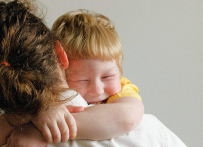Under the shade of a large tree, near where the grass meets the sand on a picturesque Queensland island, three-year-old Emanuel and his mum Lolita are spending an afternoon painting, doing puzzles and blowing bubbles. The pair are engaging in play-based learning as part of HIPPY – an early learning and parenting program – which is celebrating its tenth year in Palm Island.
Lolita and Emanuel are one of 30 families currently enrolled in the program, which is delivered by Murrup in partnership with Brotherhood of St Laurence, in the remote First Nations community.
It starts at home
A child’s first 1000 days are fundamental in establishing a range of health and developmental outcomes. The Home Interaction Program for Parents and Youngsters (HIPPY) program supports parents and carers of three and four-year-old children to be their child’s first teacher. On Palm Island, Murrup staff, who are local people themselves, visit the homes of HIPPY families and provide them with resource packs, including books, puzzles and art supplies, as well as parenting advice and referrals to health and community services.
While HIPPY enrolments are based on the age of the child participating, the program has a ripple effect throughout the whole family and the wider community. By engaging in their child’s early learning, parents and carers are more likely to be engaged in their children’s entire education journey, and be comfortable to connect with the school community. Some even report improvements in their own literacy and numeracy.

Closing the Gap
In Australia, only 16 per cent of children in remote communities start school developmentally on track. This disparity follows many Aboriginal and Torres Strait Islander children and young people throughout their education journey and beyond.
The reasons for this are many and complex.
The impacts of intergenerational trauma caused by colonial practices, including disaffection with Western-style education, as well as economic disadvantage, seasonal issues, high mobility, community and family unrest, and cultural obligations can impact a child’s school readiness and attendance. Additional factors such as food poverty, chronic health conditions, family and domestic violence and poor social and emotional wellbeing also impact a child’s ability to walk through the school gates prepared and ready for learning, or thrive once they’re there. While these issues are not unique to First Nations Peoples, they are disproportionately experienced in remote communities.
The only way to close the gap between First Nations Peoples and their non-Indigenous peers in educational and health outcomes is through self-determination and investing in place-based programs that build capacity in communities, and strength and confidence in their children and young people. Therefore, a key element of HIPPY’s success on Palm Island is that it is delivered by local people.
Keeping it local
Employing local staff to run the program means the program is contextualised to the unique aspirations and needs of the Palm Island community - a critical factor in the successful delivery of any program in First Nations communities. This model also builds capacity among Aboriginal and Torres Strait Islander people though staff development; a number of HIPPY parents have gone on to become HIPPY tutors and shared what they’ve learned with other families. And it keeps wages in community.
Importantly, local people are also able to build a unique trust and rapport with HIPPY families. For some First Nations Peoples, seeking support for their children with additional needs can carry shame and fear. Colonial practices, which involved the removal of Aboriginal and Torres Strait Islander children has, understandably, led to a distrust of community services and a reluctance to access them. Murrup staff act as a conduit between health care and education services and the families they work with, and when requested, they advocate on their behalf.

Palm Island - an island paradise
Located 65 kilometres north-east of Townsville (a 30-minute flight or two-hour ferry ride), Palm Island is magnificent. Its pristine beaches and nearby coral reef, which makes up part of the Great Barrier Reef, and steep inland mountains reach into the sky and provide forested areas and waterfalls for the local people to explore.
Today, the island is home to about 2,200 residents, of whom 90 per cent identify as Aboriginal and Torres Strait Islander Peoples. The people who live there are known as the Bwgcolman People, which means ‘many tribes, one people’. This name honours the 40-plus groups from various areas who were displaced to the island in the early 1900s.
Students from pre-prep to Year 12 attend two schools on the island, and kindergarten and daycare programs cater to babies, toddlers and young children. According to the latest census, there are 212 0-4 year olds on Palm Island. And, thanks to programs like HIPPY, there’s a cohort of well-prepared, strong and confident learners and leaders, like Emanuel, among them.
Murrup is an Aboriginal Community Controlled Organisation that partners with four remote First Nations communities to deliver place-based programs to prepare children and young people for school, support them while they’re there, and help them transition to a life of their dreams. For more information, and to support our work, please visit www.murrup.org.au.



































